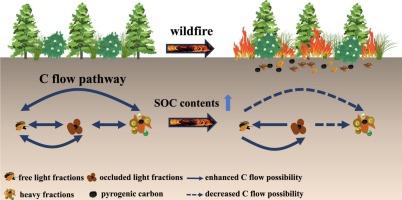野火对土壤有机碳含量和碳流路径的影响:BPCAs分子标记和13C自然丰度的证据
IF 5.7
1区 农林科学
Q1 GEOSCIENCES, MULTIDISCIPLINARY
引用次数: 0
摘要
全球范围内频繁发生的森林火灾严重干扰了土壤有机碳库,但其对土壤有机碳周转的影响仍存在争议。一个可能的原因是对热原碳(PyC)和非PyC的区分不够。在这项研究中,从六个受野火影响的地区收集了土壤样本。采用密度分馏、苯多羧酸(BPCAs)分子标记和13C稳定同位素分析相结合的方法来区分PyC和非PyC。结果表明,森林火灾发生后,游离光(fLF)、遮挡光(oLF)和重质(HF)组分的有机碳含量增加了253%。PyC占SOC增加的2.02% ~ 13.0%。土壤有机碳的增加主要是由于火灾恢复过程中植物和微生物来源的有机碳的积累。δ13C分析表明,有机碳富集方向为LF - HF。森林大火增加了土壤中δ13C的丰度,其中fLF和oLF的δ13C变化不大,而HF的δ13C显著升高,这可能是因为HF中的有机碳主要是fLF和oLF的降解产物。碳从fLF和/或oLF向HF的流动趋势减弱,表明HF中的有机碳可能接近饱和。因此,森林火灾可能通过调节土壤碳流途径,促进有机碳向稳定碳库过渡,有利于土壤固碳。本文章由计算机程序翻译,如有差异,请以英文原文为准。

Effect of wildfires on soil organic carbon content and carbon flow pathways: The evidence of BPCAs molecular markers and 13C natural abundance
Frequent wildfires worldwide have severely disturbed soil organic carbon (SOC) pools, yet their effects on organic carbon turnover are still under debate. One possible reason is the insufficient distinction between pyrogenic carbon (PyC) and non-PyC. In this study, soil samples were collected from six areas affected by wildfires. To distinguish PyC from non-PyC, density fractionation, benzene polycarboxylic acids (BPCAs) molecular markers, and 13C stable isotope analysis were combined. The results showed that following the wildfires, SOC levels in free light (fLF), occluded light (oLF), and heavy (HF) fractions increased by up to 253 %. PyC accounted for 2.02 % ∼ 13.0 % of the SOC increase. Most of the SOC increase was attributed to plant- and microbial-derived organic carbon accumulated during post-fire recovery. Based on δ13C analysis, the direction of organic carbon enrichment was from LF to HF. The wildfires increased the abundance of δ13C in bulk soils, with insignificant changes of δ13C in fLF and oLF, while δ13C in HF was significantly positive, likely because the SOC in HF is mainly the degradation product of that in fLF and oLF. The trend of carbon flow from fLF and/or oLF to HF was reduced, suggesting that the organic carbon in HF probably approached saturation. Thus, wildfires may facilitate the transition of SOC into stable carbon pools by modulating soil carbon flow pathways, which is conducive to soil carbon sequestration.
求助全文
通过发布文献求助,成功后即可免费获取论文全文。
去求助
来源期刊

Catena
环境科学-地球科学综合
CiteScore
10.50
自引率
9.70%
发文量
816
审稿时长
54 days
期刊介绍:
Catena publishes papers describing original field and laboratory investigations and reviews on geoecology and landscape evolution with emphasis on interdisciplinary aspects of soil science, hydrology and geomorphology. It aims to disseminate new knowledge and foster better understanding of the physical environment, of evolutionary sequences that have resulted in past and current landscapes, and of the natural processes that are likely to determine the fate of our terrestrial environment.
Papers within any one of the above topics are welcome provided they are of sufficiently wide interest and relevance.
 求助内容:
求助内容: 应助结果提醒方式:
应助结果提醒方式:


